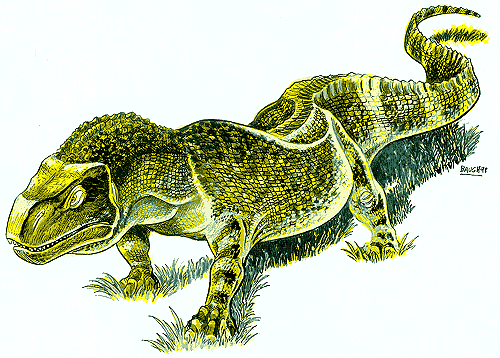Real Dragons?
Did the dragon once live?
All of the Oriental dragons were intimately associated with water. Dragons lived in lakes and rivers and seas, even in raindrops. They controlled the tides, floods and rainfall. If they really existed, then a source that immediately comes to mind is the Chinese alligator, Alligator sinensis. They are not as large as their American cousin, ranging from an average two metres in length to sometimes three metres. But they are dangerous, reptilian and water-based – all good reasons for linking them to the Oriental dragon. But only if you haven’t heard of the predecessors of the real-life Komodo dragon .
Australian monitor lizards all belong to the genus Varanus. They are easily identifiable by their streamlined shape, elongated neck, semi-erect posture, and a forked tongue – which can give the effect of fire-breathing. They all look very similar except for their size differences, which are extreme to say the least. The smallest is the pygmy monitor Varanus brevicauda (20 centimetres long, weighs 8-10 grams). The largest in Australia is the perentie or Varanus giganteus, which can attain a length of two metres.
Larger still are the Komodo Dragons (Varanus komodoensis) of Indonesia, a country that the ancient Chinese would certainly have visited. [20] They can reach lengths of three metres and weigh 150 kgs, [21] making them the world’s largest lizards. They are formidable predators, like crocodiles that are able to run quickly across land. They were probably the reason that the stegodonts (pygmy elephants) [22] became extinct in this area. They might even have wiped out the 1-metre tall, miniature humans, Homo floresiensis, who lived there up until 12,000 years ago.
These dragons were previously more widespread, with evidence of them once occurring in Mongolia coming to light. [23] And in Queensland, Australia, only becoming extinct 19,000 years ago (take that date with a pinch of salt), was a bigger lizard still, a cousin of the Komodo dubbed Megalania prisca.

Megalania prisca, as we have learned from fossil evidence, grew to be a staggering seven metres in length and weighed 600 kgs [24]. Although it was technically a lizard, it must have had the presence of a dinosaur, and almost certainly ate a few of the humans of that era. But it’s usual meal was more likely to have been rhinoceros-sized wombats. [Strange days indeed with gigantism seeming to be rampant.] These meals are believable when you consider that Komodo dragons have been known to kill water buffalo weighing three times more than themselves. [25]
Which brings us back to ancient Rome! Pliny, the Roman naturalist, said that the dragon of India was
“so enormous a size as easily to envelop the elephant with its folds and encircle with its coils. The contest is equally fatal to both; the elephant, vanquished, falls to the earth and by its weight crushes the dragon which is entwined about it.”
He also mentioned the dragons of Ethiopia, which, with a length of only thirty feet, were too small to kill elephants. Other European myths state that dragons always jumped onto elephants from out of trees. Is this all just fantasy, amazing stories concocted to scare children with? Or is it just as reasonable to suggest that dragons once lived?
So where are we heading? On the one hand there are myths connecting dragons to global destruction and rebirth. On the other are links to DNA, ancient languages, ancient calendars and the I Ching. And now I am taking a big breath and suggesting that the mythical dragons were rooted in reality, that knights in shining armour actually killed real dragons, and somehow it all makes sense. This is where a new theory of evolution comes in.. stay tuned.
[20] Some ancient Chinese texts even tell of Australian kangaroos and boomerangs

